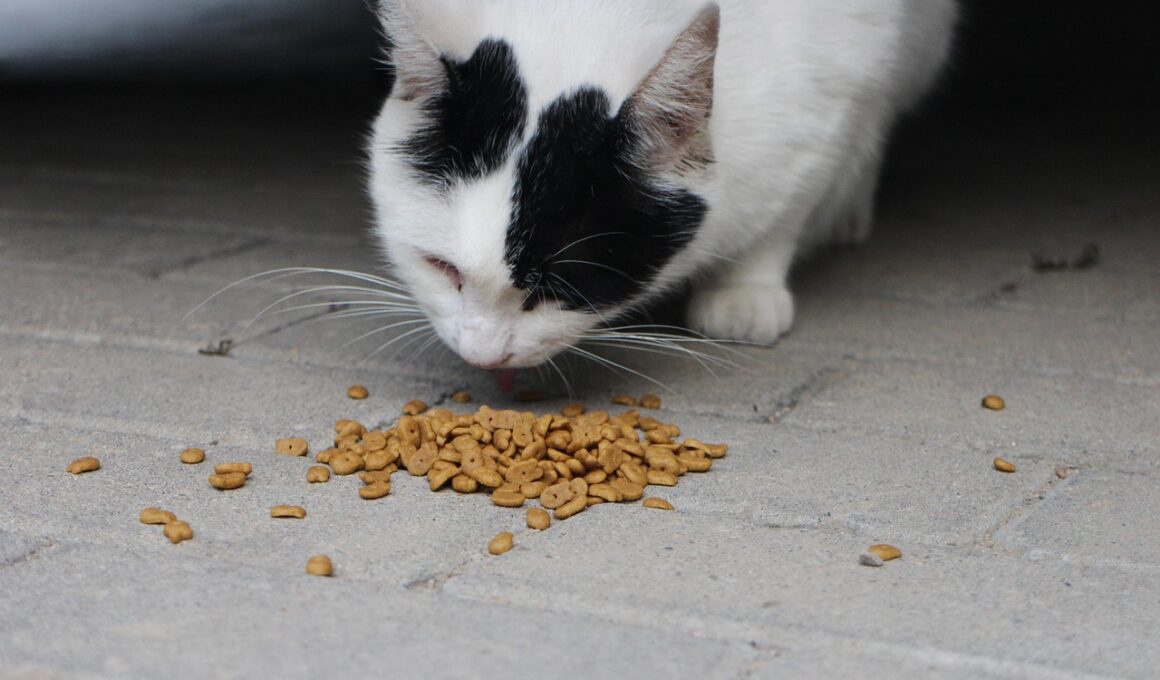How to Transition Your Cat to Dry Food Safely
Transitioning your cat to dry food can be a challenging process, but it’s essential for their health and well-being. Cats are traditionally obligate carnivores, so moving them from wet food can be tricky. Start by selecting a high-quality dry cat food with excellent nutritional content. Look for options that list real meat as the first ingredient to ensure optimum protein levels. You may also consult your veterinarian for recommendations suited to your cat’s needs. Educate yourself about your specific cat’s dietary requirements, and make sure the chosen dry food aligns with those requirements. Cats require a blend of nutrients, such as proteins, fats, vitamins, and minerals. Once you have selected the food, keep in mind that the transition should be gradual. Rapid changes may lead to digestive issues. Begin by mixing a small portion of dry food with their current diet, slowly increasing the dry food ratio day by day. This gradual approach helps your cat adjust smoothly to the new diet and minimizes digestive upset.
A slow transition is crucial for a successful switch. For instance, during the first week, consider starting with a 75% wet food to 25% dry food ratio. Over time, gradually adjust this ratio to 50% wet and 50% dry, and then to 25% wet food and 75% dry food. By the end of the transition, your cat should be consuming only the dry food. Monitor your cat’s response closely throughout the process. Look for any signs of aversion or digestive trouble, such as vomiting or diarrhea. If you notice such symptoms, consider slowing down the transition process. Consistency is vital, both in the diet and in feeding routines. Whenever possible, try to stick to regular feeding times and avoid leaving food out for extended periods. Providing fresh water is equally important, as proper hydration supports their digestion and overall health. Cats often naturally drink less when eating dry food, so encourage them to drink regularly. Always have clean water available in their accessible bowls.
Understanding Your Cat’s Nutrition Needs
Understanding your cat’s nutritional needs is vital for a successful dry food transition. Cats need balanced diets tailored specifically to their physiology. Protein should be the primary component, as it is essential for muscle maintenance and energy. Carbohydrates are less critical for cats than for other pets, yet dry foods sometimes include them in various forms. Check the labels to ensure the contents are rich in protein and contain minimal fillers such as corn or soy. Vitamins and minerals like taurine, arginine, and B vitamins are also necessary to support various bodily functions. Before making changes to your cat’s diet, you should review any health concerns or specific requirements with animal professionals. Some cats may have allergies or intolerances to certain ingredients which can lead to poor reactions when transitioning to dry food. Hence, choosing the right formula should be a careful process to prevent adverse outcomes. Observing your cat during this time will help gauge their preferences and nutritional absorption. Always be open to adjusting the plan based on their individual dietary responses.
As your cat gets accustomed to a new diet, it is a good time to monitor their overall health and behavior. Changes in eating habits, fur quality, and energy levels can indicate how well they are adjusting to the dry food. A premium dry cat food will help maintain their dental health, reducing tartar build-up and promoting fresh breath as cats chew on the kibble. Regular vet visits are essential during this process to ensure that any potential health issues are addressed promptly. Besides, the vet can track changes in weight and recommend adjustments if necessary. Establishing a routine for meals is another component of a successful transition. Feed your cat multiple small meals throughout the day instead of one large meal. Doing so mimics their natural feeding habits and helps in digestion. This will also encourage them to seek food at regular intervals. Maintain consistent feeding times and avoid giving unpredictable snacks or treats that may disrupt their appetite for dry food. Figuring out their favorite flavors and textures will ensure they maintain interest in their diet.
Monitoring the Transition Process
Throughout the transition, be attentive to signs of stress or discomfort. Every cat is unique; therefore, some may adjust more quickly than others. Keeping a diary of their reaction can be beneficial for understanding their journey during the diet switch. Track how they respond to the dry food, including their behavior toward it, how they eat, and any signs of stomach upset. If an adverse reaction occurs, consider reverting to the previous diet. It’s worth noting that switching back temporarily is sometimes necessary before trying a different dry food brand. If you see consistent distress, consult your veterinarian for further guidance on suitable options based on their specific needs. Adjust the pace of the transition as needed to ensure it becomes a positive experience for your feline friend. Regularly check their body weight, coat condition, and general mood throughout this process. Engaging with your cat through play and affection will help maintain a strong bond during this change. Keeping their environment stable raises the likelihood of a smoother adjustment.
It’s essential to keep the long-term in mind while transitioning your cat to dry food. Proper hydration should never be overlooked. Always offer fresh water at all times to maintain hydration levels. Even when adjusting to dry kibble, hydration is crucial to prevent urinary tract problems as dry food can reduce water consumption. Additionally, try incorporating wet food occasionally back into their diet for added moisture and palatability without reverting to solely wet food feeding. Engaging with your cat in playtwo three times a week can also assist their psychological well-being during this transition. Routine dental care should also remain a priority, as healthy teeth contribute to overall health. Regular vet visits allow for early detection of any issues related to dietary changes. Over time, consistency will lead to your cat feeling better and maintaining a healthy weight. Gently transitioning your cat to dry food is a journey that can ultimately enhance your cat’s quality of life. Each cat adapts differently, but with patience and observation, the transition can be simplified for both you and your pet.
Conclusion on Dry Food Transition
The transition to dry food can seem daunting, but with careful planning and consideration, it can lead to positive outcomes for your cat. The right dry food can enhance their health, aiding in dental health, weight control, and ease of feeding. It is paramount to remember that every cat is unique, with individual interests, preferences, and health needs. By taking a gradual approach and playing an active role during this process, you will not only facilitate a smoother transition but also solidify the bond between you and your pet. Consulting with your veterinarian regularly during this adjustment phase will to help address potential issues and adjust feeding methods as necessary. Continuing to educate yourself on feline nutrition is also beneficial. Understanding their behavior will enable you to make informed decisions that cater to their preferences and enhance their well-being. Ultimately, the benefits of a balanced dry diet can promote a healthier and happier pet. Follow these guidelines, and you are well on your way to ensuring that your cat thrives on their new dry food diet.


